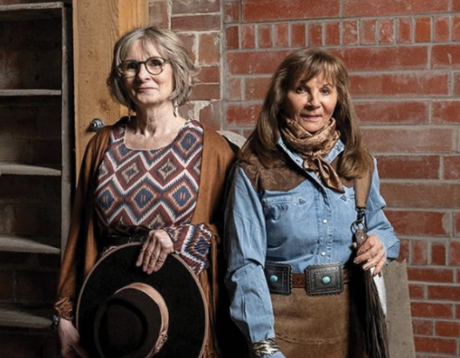Chilcotin Mountain Racers
Photos by Liz Twan
For many years the Mountain Race, held from 1922 to 1953, was considered the highlight of the Williams Lake Stampede. It was a mad dash, no-holds-barred race from the top of the mountain, down a twisting trail, across the main road and then onward into the Stampede grounds to finish in front of the crowd.
The riders were all very brave or “just plain fearless” depending on your personal outlook. Most of them were men (a few ladies), most of them were of First Nations descent and many of them were exceptional horsemen. They rode to the top of Fox Mountain and jostled and bumped together jockeying for a good position at the start line. The starter fired his gun and then they were off, “racing hell-bent for election” – it was total mayhem.
Down below the waiting crowd leapt to their feet; many using binoculars to view the mad charge, straining to see if “their” rider was at the head of the pack. Much money changed hands before and after the race as unofficial bets were won or lost. There were loud and heartfelt collective sighs and groans as the racers, in one fashion or another, came running or tumbling, pell-mell down the mountainside.
I
t was a thrilling and exciting end to a weekend display of unique western skills by the men and women of the West who carved out ranches in the middle of nowhere. They were tough and somewhat fearless, a little different breed than those who liked the settled life in the towns and cities of B.C.
Who were these mountains racers?
In the old days, they were cowboys – some of the finest that ever worked the ranches of B.C.
Antoine Harry, mentioned in the excerpt from the Vancouver Daily Province, was an exceptional cowboy. He was of First Nation descent (Secwepemc-Shuswap) and was born, raised and buried (2007, age 80) in the little community of Dog Creek, about 70 miles southwest of Williams Lake, B.C. Quiet and unassuming; in fact virtually unheard of outside of local rancher/cowboy circles, he was an excellent horseman and cowboy in every sense of the word. Antoine spent all of his working days in and around Dog Creek, most of his career on the Circle S Ranch working for the Spencer family, often under the management of Frank Armes, who spoke very highly of Antoine’s skills and abilities.
The men of the Esketemc First Nation (Alkali Lake), also Secwepemc, laid claim to many “Mountain Race Champion” titles including; Pierro Squinahan and Patrick Chelsea (one of the famous Alkali Lake Braves hockey team members). Other contenders included brothers Joe and Matthew Dick.
Other names inscribed in history as winners of the Mountain Race are local cowboys and characters, many of them legends of their time. Jo Flieger was a three-time winner, riding a great grey horse aptly named Grey Eagle. Together they conquered the mountain in 1923, 1924 and 1926. He was one of the men responsible for originating the Williams Lake Stampede. Jo also laid out the original course.
It was described as follows; “It dropped from a narrow ridge, down a steep gulch, after which the riders had to make their way through thick brush, deadfall trees, rocks and loose gravel to yet another ridge and down a treacherous slope. Then you had to clear the highway (often the horse took one huge leap) and rush down the last hill to the racetrack for a final (1/4 mile) run to the finish.”
One of the very few, and the earliest woman, to challenge the mighty mountain race course was Ollie Curtis. Many years later Ollie, now Matheson, was interviewed by local historian Irene Stangoe for her book; Cariboo-Chilcotin, Pioneer People and Places.
About the mountain race, Ollie is quoted as saying, with a smile, “I liked it. It was a challenge, but my Dad almost had a fit… and so did some of the cowboys. You had to have a heavy, well-built, very sure fitted horse. There was no trail, just markers to guide the riders so they wouldn’t get hung up in the bush.”
Continuing, Stangoe notes that Ollie participated for three years, beginning at age 17, coming in second or third each time. The 1926 race, she told Irene, stood out from the rest. There were ten riders that day…
Ollie remembered, “A few of us decided to hold back, it was a wise decision as the horses all jammed up on the narrow trail, sliding and slithering, all desperately trying to keep their footing. Half of them fell, rolling on top of one another. One horse broke its neck and had to be shot, others were badly injured, as were several riders who were hospitalized with bruises and broken bones.”
Ollie, who made it to the finish says, “I was just happy to come in with my horse on its feet.”
The other woman competitor from the earlier years was Hazel (Smith) Exshaw, the sister of Lloyd “Cyclone” Smith (expert horseman, pick up man and cowboy) who was quite a horsewoman in her own right. Hazel entered the final Mountain Race in 1953, a fact not really noteworthy other than her gender. But, add the detail that she was a 57 year-old grandmother at the time and you get an illustration of “Cariboo guts and grit”. Despite losing a stirrup and being off-balance for most of the race, Exshaw crossed the line in third place.
The race was abandoned after 1953 for various reasons, mainly due to the buildup of the town and the paving of the highway that intersected the race route.
| “Two spills, one horse killed, and an 18-year record shattered. Those were the highlights of this year’s famous mountain race at the Williams Lake Stampede.
“The race, traditionally one of the final events of the big annual show, was won by Antoine Harry of Dog Creek, whose big grey literally flew down the tortuous mountain course to cross the finish line in one minute and twenty-nine seconds. “His record beat the one set by Charlie Mouse (author’s note – likely Mouise) of Sugar Cane Reserve, Williams Lake, who made the run in 1:55 back in 1927. “Sunny Sand, owned and ridden by Joe Dick, Alkali Lake, lost it’s footing near the start of the race and broke its leg in the resulting spill. “Louis Bates, favoured to win, was knocked out of the race when his horse fell in the same tangle.” June 12, 1945, Special to the Vancouver Daily Province |
Jump forward to the late 1980s and a dilemma facing the Stampede directors; how to bring local people back to Stampede? How about a mini-mountain race with only local entrants? Everyone loves a race.
The race was reinvented for modern times, with equine and human safety at the top of the course requirements. A trail was cleared and staked, entries were taken and the racers were off before they knew it.
One of the first modern-day racers to challenge the “hill” was Alkali Lake’s Bill Chelsea. The “need for speed” and riding fast down steep hills horseback, throwing caution to the wind must be hereditary. Patrick Chelsea, Bill’s father, was one of the successful First Nation riders of the early days at Stampede; he mountain raced and flat-raced, a real horseman and cowboy.
Bill and his buckskin horse, “Mr. Little” owned the new Mountain race hill. Every time he rode Mr. Little, Bill won. Mr. Little started his career with Bill (acquired in a horse trade, and that guy was sorry ever after) as a team roping horse (AQHA), but he truly loved to run. Bill raced him with a light aluminum bit and a loose chin strap. They won five mountain race titles together, before Bill retired Mr. Little and then himself.
For a couple of years in the early 1990s interest in entering the race faded a bit and the decision was made to open the entries to anyone. One new racer who turned up was Kathleen Gottfriedson who hailed from the tiny Okanagan town of Cawston, B.C.
Kathleen didn’t travel all that way to lose. At Stampede 1996, the horn sounded, the racers took off and at the first corner there was the lady, in red, riding ‘Red’ in the lead!
Lead she did, from the first corner and all the rest of the race, there was no doubt and no keeping up. A new champion had arrived. At the time, she was a thirty-two year old mother of three, who had trained her own horse. Kathleen and her horse were fearless, well trained and conditioned and there was no catching her. She ruled the mountain in 1996 and 1997. So good in fact, that no one else wanted to challenge her, so entries went down again and the 1998 race was back to “locals only.”
Ever since then the race has thrived as one of – if not THE – most popular features of the Williams Lake Stampede today.
Bill Chelsea retired a few years ago, but un-retired last year so he could race against his younger brothers, Edward and Anthony, who have both been champions in the past few years.
Other regular entrants include Chief Roger William (Nemiah Valley), Darren Sulin (Hanceville), Doug Alexis, Howard Lulua, Dane Alphonse, Sandy Johnson, Douglas Sill and more.
Mountain races are unique to B.C. Nemiah Valley hosts a yearly race in conjunction with their annual B.C.R.A. rodeo and Chief Roger William is a regular winner on his home course. There is also one held at Tsi Del Del Rodeo, Redstone, B.C. most years.
Please be advised, it is not a sport for “sissies or the faint of heart.”



















